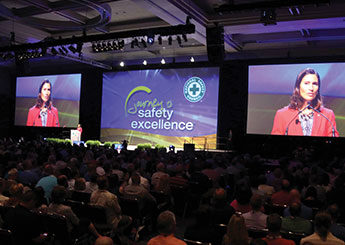Highlights from the 2014 NSC Congress & Expo

Michaels and Hersman: ‘Safety pays’
On Sept. 16, during the 2014 NSC Congress & Expo, OSHA and the National Safety Council renewed their Alliance – agreeing to work together to foster safer and healthier workplaces. Here, OSHA administrator David Michaels and NSC President and CEO Deborah A.P. Hersman offer their shared view on the importance of employer investment in safety.
When Paul O’Neill became CEO of Alcoa, he gave every employee his home phone number and asked them to call any time of day if they identified something that put them or a co-worker at risk. O’Neill was sending a clear message to his employees: Keeping them safe was his No. 1 priority – above profits and production.
Alcoa thrived. From 1987 to 1999, the company reduced its lost workday rate from 1.86 to 0.23. Simultaneously, Alcoa’s market value increased from ?$3 billion in 1986 to $27.5 billion in 2000.
Safety pays. Employers that focus on employee health enjoy higher worker morale and performance, experience fewer health care costs, and are better equipped to weather economic recessions.
Yet, 12 workers are killed on the job every day in the United States, and more than 10,000 suffer a serious injury.
The numbers of deaths and injuries have improved significantly since passage of the Occupational Safety and Health Act more than 40 years ago. But far too many workers still do not leave work in the same condition that they arrived.
Workplace injuries, illnesses and fatalities take an enormous toll, not only on workers and their families, but also on our nation’s economy and businesses. Fatal and nonfatal work injuries cost our economy $198.2 billion each year – that’s over half a billion dollars every day!
Investing in safety makes financial sense. Unfortunately, misperceptions abound about the cost of providing safe and healthful workplaces. Some employers believe compliance with federal safety and health standards will be too costly. Many have an “it won’t happen to me” attitude, and others simply prioritize financial gains over protecting people. But data shows that investing in safety is not just prudent, it is also profitable.
This is demonstrated routinely at companies that belong to the Campbell Institute, the global Environmental, Health and Safety (EHS) center of excellence at the National Safety Council. Schneider Electric, DM Petroleum and Fluor Hanford – all winners of the prestigious Robert W. Campbell Award – saw reductions in workers’ compensation costs following implementation of strong EHS programs.
Schneider Electric’s workers’ compensation costs dropped 40 percent, and the company is projected to save $10 million. DM Petroleum’s management system resulted in reduction of waste generation and spill incidents, accounting for more than $3.8 million in cost avoidance. Fluor Hanford reduced workers’ compensation costs by $7 million annually.
The National Safety Council also tracked the market value of some publicly traded Campbell Award winners. Schneider Electric’s stock leaped from $22.59 per share in 1999 to $60 per share in 2013. DM Petroleum jumped from $32.71 to $51.41, and Fluor Hanford grew from $31.75 to $64.25.
Once employers understand the connection between safety and financial health and wellness, many act accordingly.
Creating a safety culture is not a singular moment; it’s a journey. Employers must commit to continuous risk reduction with a goal of zero injuries. Even employers with world-class safety programs have to double down and recommit to safety every day.
Actions speak louder than words. If safety is the cornerstone of business vitality and achieved through risk reduction, leadership and employee engagement are linchpins.
Not every CEO must give employees a personal phone number. But every CEO must be a watchdog not only for the financial well-being of the company, but for the welfare of his or her employees. The best CEOs understand that the two are not mutually exclusive.

 |
 |
|
Deborah A.P. Hersman President and CEO National Safety Council |
David Michaels Assistant Secretary of Labor OSHA |
Post a comment to this article
Safety+Health welcomes comments that promote respectful dialogue. Please stay on topic. Comments that contain personal attacks, profanity or abusive language – or those aggressively promoting products or services – will be removed. We reserve the right to determine which comments violate our comment policy. (Anonymous comments are welcome; merely skip the “name” field in the comment box. An email address is required but will not be included with your comment.)

